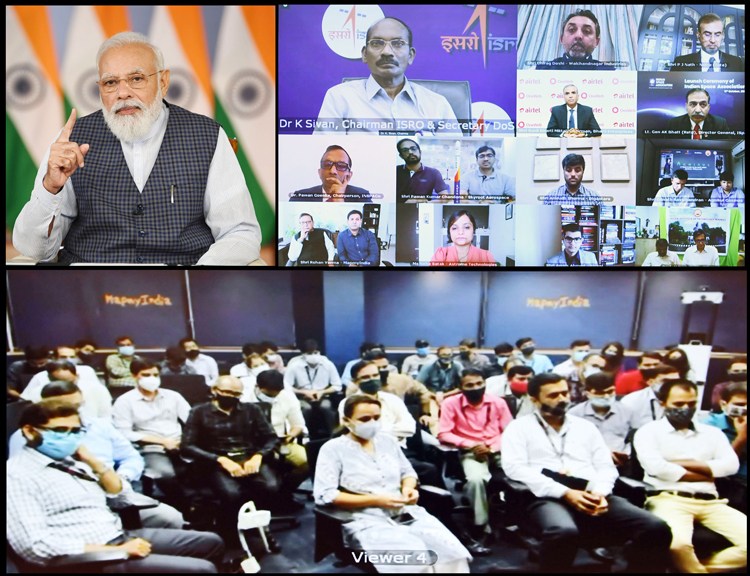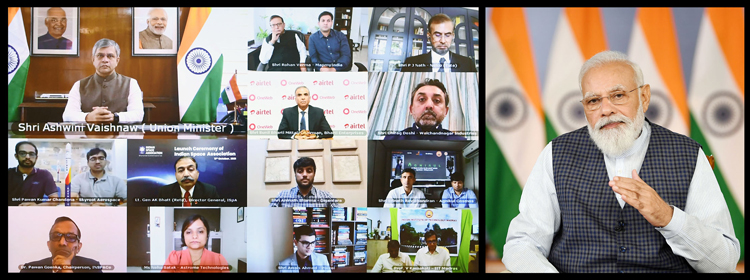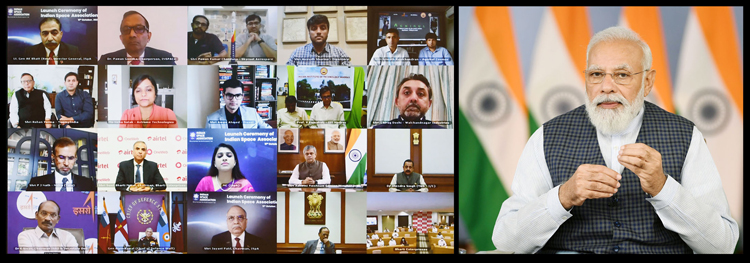INDIAN ARMED FORCES CHIEFS ON
OUR RELENTLESS AND FOCUSED PUBLISHING EFFORTS

SP Guide Publications puts forth a well compiled articulation of issues, pursuits and accomplishments of the Indian Army, over the years

I am confident that SP Guide Publications would continue to inform, inspire and influence.

My compliments to SP Guide Publications for informative and credible reportage on contemporary aerospace issues over the past six decades.
Indian Space Association (ISpA) Launched
ISpA will undertake policy advocacy and engage with all stakeholders in the Indian Space domain. This will include the government and its agencies, to make India self-reliant, technologically advanced and a leading player in the space arena.
 |
The Author is Former Director General of Information Systems and A Special Forces Veteran, Indian Army |

On October 11, 2021 Prime Minister Narendra Modi digitally launched the Indian Space Association (ISpA) - the premier industry association of space and satellite companies. Founding members of ISpA include Bharti Airtel, Larsen & Toubro, Nelco (Tata Group), OneWeb, MapmyIndia, Walchandnagar Industries and Ananth Technology Limited. Other core members include Godrej, Hughes India, Azista-BST Aerospace, BEL, Centum Electronics and Maxar India.
Launching ISpA, Prime Minster Modi said, “The major reforms that are happening in India today regarding space sector and space technology are a link to this. To facilitate private sector’s participation, the government has also formed IN-SPACe. It will work as a single-window independent agency for all space-related programmes. This will further speed up projects of the private sector. Today government is sharing its expertise and providing launch pads for the private sector. Today, the facility of ISRO is being opened for the private sector,”
India’s space economy is barely $7 billion - less than 2 per cent of the global market and ISRO and Indian industries must develop space-based services to bolster India’s Space economy
He further said, “The country is witnessing dynamic reforms today because our vision is clear. The vision is Atmanirbhar Bharat. It is not just a vision, but a well-thought, well-planned integrated economic strategy that will turn India into a global manufacturing hub and a global innovation centre. In the last few years, our focus has not just been on research and development of new technologies, but also on ensuring its reach to the common citizen. In the last seven years, we have used space technology as a key tool to ensure last-mile delivery and transparent governance. I once again congratulate all of you for the formation of the Indian Space Association.”

Prime Minister Modi elaborated on the Government's approach to space reforms which is based on four pillars:
- The freedom of innovation to the private sector;
- The role of the government as an enabler;
- Preparing youth for the future, and;
- To see the space sector as a resource for progress of the common man.
He said this is the time of exponential innovation and the government must act as an enabler rather than handler to attain the objective. A strong space sector reinforces other sectors in producing better forecast for farmers, fishermen, stringent scrutiny of ecology and better estimates of future natural disasters. He pointed out that India is among a few countries with end-to-end capability in space.
Department of Space (DOS) had forecasted that Indian Space Industry could grow to $50 billion by 2024 provided the right policies are put in place
ISpA will undertake policy advocacy and engage with all stakeholders in the Indian Space domain. This will include the government and its agencies, to make India self-reliant, technologically advanced and a leading player in the space arena. Interestingly, two days before the launch of ISpA, a virtual event was organised by the Confederation of Indian Industry (CII), veterans of Indian Space Research Organisation (ISRO) and Indian space-sector entrepreneurs had discussed how India could evolve its space ecosystem for balanced growth as a manufacturing hub, highlights of which are as follows:
- The ecosystem and space industry via public-private partnerships fostered by ISRO over past four decades needs to be scaled up and made more inclusive by involving academia and research institutions at a greater level ensuring better coordination in the future amid the growing global competition.
- Highly competitive segments in the space industry would be affordable launches, increased launch choice, increased resolution of commercial space-based imaging. India’s space economy is barely $7 billion - less than 2 per cent of the global market and ISRO and Indian industries must develop space-based services to bolster India’s Space economy.
- Private industry is working on fabricating rocket engines for ISRO and also as competitors in many other streams; private industry could simultaneously collaborate and compete in different domains. A manufacturing hub should offer a wide-range of products for civil and military purposes for which support infrastructure like machine tools, facilities, and consumables must be encouraged, most of which are not readily available presently - an ecosystem must be based on industry requirements.
- Enough demand and enough solutions providers are required to meet both sides of the economic equation. Small companies can’t place large orders but when companies across the sector come together and place a large order, it will benefit everyone, provided the same component is used – same goes for semiconductors.
- To cater for foreign demands with possibility of 30,000 satellites being launched over the next decade, Indian companies could collaborate to offer products and services to cater towards foreign demand as well.
The Indian Space Industry employing over 45,000 people may be $7 billion presently but Antrix Corporation, under administrative control of the Department of Space (DOS), had forecasted it could grow to $50 billion by 2024 provided the right policies are put in place. This appears more than possible now with Prime Minister Modi stating during the launch of ISpA on October 11 that reforms in the space sector would make India the world’s hub for the cost-effective launch of satellites as well as supplier of critical components for the entire end-to-end space system supply chain.
Armed Forces must be incorporated in the trials and developments right from the beginning. Future wars would be multi-domain operations by joint forces requiring high-speed connectivity crucial for situational awareness and the common operational picture of all domains.
The Indian Armed Forces will no doubt gain from the establishment of ISpA in boosting their combat potential. Speaking at the ISpA launch, the CDS General Bipin Rawat said, "Space and cyber domains have become critical to our ability to undertake operations across the spectrum, both in peace and conflict. While ISRO will continue to provide leadership and guidance, the Armed Forces look forward to the Indian industry to provide products and innovations and cutting-edge technologies towards war winning capabilities. Indian Armed forces are significant users of diverse space products including communication, position navigation and timing, and of course, intelligence, surveillance, and reconnaissance. And apart from this, space situational awareness, and protection of our space based assets have become important domains.”

A related development is another revolution taking off with global players seeking to establish pan-India satellite based broadband services and 5G cellular communications in collaboration with Indian companies. 5G communications network would connect virtually everyone and everything together including machines, objects, and devices facilitating the real-time exchange of information in an ever-dynamic operational environment that the militaries operate in; realising Internet of Things (IoT) in the Tactical Battle Area (TBA) and providing the potential essential infrastructure. 5G will support crunching data generated by millions of battlefields IoT sensors instantaneously and delivering required information to the best shooter and the appropriate decision-maker at high speeds. This will enable easy handling of AI-enabled platforms which are expected to continue multiplying exponentially.
In view of the above, the Armed Forces must be incorporated in these trials and developments right from the beginning. However, it will need to be ensured that as and when the Armed Forces adopt such technologies, the security of such networks must be foolproof. Future wars would be multi-domain operations by joint forces requiring high-speed connectivity crucial for situational awareness and the common operational picture of all domains. For the interim, especially with PLA troops massed along our entire border with China, the Mobile Integrated Network Terminal (MINT) of the Indian Army, which is based on the Network in a Box (NIB) solution of the Long Term Evolution (LTE), must be speedily rolled out and inducted.





